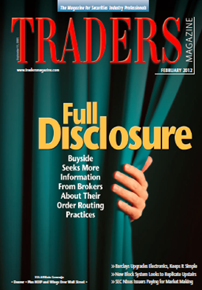Traders Mag Feb-2012
In the Feb 2012 issue of “Traders” magazine , I found these points worth noting down :
-
A 300 page document, Volcker rule, signed into law in July 2010, prohibits U.S. banks from engaging in proprietary trading as of July 2014. This rule is similar to “asking you to switch off mobile phones” in the flight. The chance of electronic signal messing up with aircraft is 1 in million. For most of the passengers this does not make sense. But we still have been following this switch off iPods/electronic devices for the past 20 years. Volcker rule banning prop trading is supposedly a protection against trades that can pull down the entire system. Prop trading accounts for 11% of trading volume. So, who will fill in as liquidity providers ?
-
Buy Write funds are making a comeback, thanks to low yielding Fixed income funds
-
Citi rolls out pairs algo
-
Well, Pairs was first used at Morgan Stanley in 1987. 25 years later, Citi is rolling out some variation of this algo. The strategy is the same,find stocks which show cointegration. But the change that is happening over the years is – Execution. Alpha lies in execution.Like my friend who says, there are only about 10 HFT strategies that are all well known. The secret lies in execution. So, another 10 years from now, I guess we will still see a new pairs algo released by firms, but it will more and more look like a sell side algo than a buy side algo.
-
Book review of “Street Freak” – experience recounted by Jared Dillian , a former coast guard officer who became a trader at Lehmann. The review says,” Dillian writes very well and at times has the sensibilities of a brilliant fraternity- house party boy let loose on Wall Street. One stays with the book to the end for the same reason people can’t take their eyes off a train wreck and will then speak about it in hushed tones for weeks afterward.
-
Considering that the trading in US is scattered around 13 exchanges and more than 40 execution avenues, price discovery has become an issue.There is a proposal made by NASDAQ to SEC to allow companies to opt out of a fragmented market
-
Top Predictions for 2012
-
Even though there is a talk of regulatory changes that would be in place, one should remain skeptical. Why will the govt put in place some regulatory changes, knowing the presidential elections are in Nov and they will be relooked at , under the new administration in 2013
-
New Threshold Proposals to control market volatility will be put in place
-
Better definitions for HFT from SEC
-
Bull market for paper work. More algo supervision leads to an insane demand for paperwork.
-
End of Prop trading. Most of the banks are already out of it.
-
Consolidation of dark pools
-
Many of the much heralded exchange mergers of 2011 never came to pass: ASX/SGX, TMX/LSE and NASDAQ/ ICE/NYSE all fizzled out. This year might not see a slew of mergers, but a number of innovative alliances are in the works.
-
An ex-Jones trading guy reads the book ,”The Electronic Call Auction” from a Baruch professor, and launch a start up , Ax ATS that automates “upstairs trading”.
-
SEC Squashes market making proposal - The SEC rejected a proposal by Nasdaq to establish a “Market Quality Program” that would permit issuers of exchange-traded funds to pay market makers to quote these funds on Nasdaq’s flagship exchange. The proposal was intended to be followed by a similar proposal from Nasdaq’s new BX Venture Market for small capitalization stocks. The exchange operator plans to launch BX Venture this year. Behind both proposals is an attempt by Nasdaq to solve a longstanding problem of illiquidity in small cap stocks.
-
Buy side has only an illusion of control, most part of the actual trade path is not known to the buy side trader fully. Post Pipeline disaster buy side has demanding more transparency.
-
Basic conflict of interest is Buy side want Best Execution and Sell side seeks Best Price
-
A recent study by Pragma Securities found that routing behavior is influenced by fee structures, with brokers tending to prefer cheaper venues when price is held equal.
-
Rosenblatt reported that when combined, dark pool and exchange dark volumes are 15.3 percent of U.S. equity trading.
-
Increasing concentration of HFT in dark pools make it difficult for a buy side to follow an algo more than a couple of months. It has to keep changing execution algos to prevent getting gamed by HFT players
